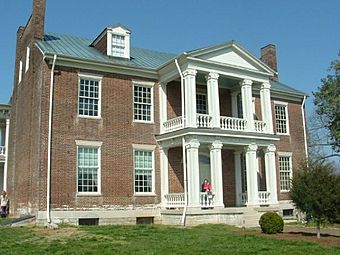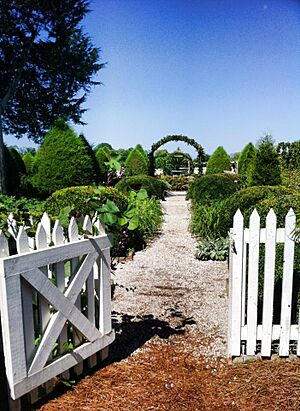Carnton facts for kids
Quick facts for kids |
|
|
Carnton
|
|

Carnton
|
|
| Location | 1345 Eastern Flank Circle, Franklin, Tennessee |
|---|---|
| Area | 48 acres (19 ha) |
| Built | 1826 |
| Architectural style | Federal; Greek Revival |
| NRHP reference No. | 73001857 |
| Added to NRHP | January 18, 1973 |
Carnton is a historic house built in 1826 in Franklin, Tennessee. It is located in Williamson County, Tennessee, United States. This property was once a large farm, known as a plantation. It became very important during and after the Battle of Franklin in the American Civil War.
Carnton was less than a mile (1.6 km) from where the battle happened in 1864. It became the main temporary hospital for injured soldiers. Over 1,750 Confederate soldiers died at Franklin. The bodies of four Confederate generals were placed on Carnton's back porch after the battle.
A best-selling book called The Widow of the South (written by Robert Hicks in 2005) tells the story of Carrie Winder McGavock. She lived at Carnton during the Civil War. Carnton was recognized as a historic place in 1973. Today, it is a museum managed by The Battle of Franklin Trust.
Contents
Exploring Carnton's Design and Gardens
The House's Look and Feel
Carnton is a red brick house with 11 rooms. It was finished in 1826 by Randal McGavock. People who were enslaved built the house. It has a Federal-style design. The front of the house faces south and has two stories.
In 1847, Randal's son, John McGavock, added a Greek Revival-style porch to the front. This porch has four tall, square columns. It also has a balcony on the second floor. The back of the house has a similar two-story porch with seven columns. This back porch runs along the entire length of the house.
Inside Carnton's Walls
The inside of Carnton also has Greek Revival touches. John McGavock updated it in 1847. He added new wallpapers, special paint effects, and carpets. Three different wallpaper patterns have been found on the third floor.
The main hallway downstairs looks much like it did during the Civil War in 1864. The wallpaper there is a copy of a popular design from that time. The living room also got a Greek Revival update. This included a new fireplace mantel, wallpaper, and carpet.
Some items in the house belonged to the McGavock family. These include a working clock, a 200-piece china set, and a rocking chair given by President Andrew Jackson. Many of Carnton's floors are stained. This is because the house was used as a Confederate hospital. The darkest stains are in a bedroom that was an operating room. Blood soaked through the carpets and into the wood floors.
The Beautiful Grounds
Randal McGavock planted cedar trees along the driveway. His son, John, added more cedars and boxwood plants. He also put in a brick walkway between the front porch and the driveway.
Before his marriage in 1847, John McGavock created a 1-acre garden. This garden was inspired by Andrew Jackson Downing, a famous landscape architect. The garden had vegetable beds surrounded by pretty borders. A large Osage orange tree in the middle suggests that vegetables were later grown further from the house.
A white picket fence and a tall board fence surrounded the garden. This protected the plants from animals and bad weather. It also gave privacy to the family from the many enslaved people working outside.
The garden was not cared for during the 1900s. But old photos, letters, and digging helped recreate it in 1996–97. It now looks like it did in 1869. The garden has a large collection of daffodils, hostas, and peonies. All these plants were available in Tennessee before 1869. Carnton is thought to have the biggest collection of historic daffodils in the South. It has 40 different types from before 1869.
McGavock Confederate Cemetery
To the northwest of the house is the McGavock Confederate Cemetery. It covers 2 acres of land. This is the largest privately owned military cemetery in the United States. The McGavock family gave this land for soldiers killed in the Battle of Franklin to be buried. The cemetery is organized by state, with 13 sections. The Franklin Chapter of the United Daughters of the Confederacy takes care of the cemetery.
Carnton's Past: A Look Back
The 1800s
Randal McGavock (1768-1843) moved from Virginia to Nashville, Tennessee. He became an important local politician. He was the Mayor of Nashville in 1824. He knew President James K. Polk and was good friends with President Andrew Jackson. Jackson visited the McGavocks more than once.
Randal McGavock named his property "Carnton" after his father's birthplace in County Antrim, Ireland. The name comes from a Gaelic word meaning "a pile of stones." A cairn sometimes marks a burial site.
The first building at Carnton was a smokehouse in 1815. The main house was built in 1826. The mansion sat on 1,400 acres (6 km²) of land. About 500 acres (2 km²) were used for farming. The McGavocks grew crops like wheat, corn, oats, hay, and potatoes. They also raised and bred livestock and thoroughbred horses.
Randal McGavock died in 1843. His son John (1815–1893) inherited Carnton. In 1848, John married his cousin Carrie Winder (1829–1905). Carrie Winder McGavock is the subject of the 2005 book "The Widow of the South." She brought an enslaved person named Mariah Reddick with her. John and Carrie had five children, but only two lived to be adults.
The Battle of Franklin's Impact
When the Civil War started, John McGavock was 46. He was too old to join the army. But he helped get supplies for Southern soldiers. Carrie sewed uniforms for family and friends. As the war got closer, John McGavock sent most of the enslaved people he owned to Louisiana. He wanted to prevent Federal authorities from taking them.
When Federal troops took control of Middle Tennessee, they learned the McGavocks were helping the South. They took thousands of dollars worth of grain, horses, cattle, and timber from the farm.
On November 30, 1864, Carnton became the largest temporary hospital after the Battle of Franklin. The house was less than a mile (1.6 km) from the battle. Over 1,750 Confederates died at Franklin. The bodies of four Confederate generals—Patrick Cleburne, John Adams, Otho F. Strahl, and Hiram B. Granbury—were placed on Carnton's back porch for a few hours.
The McGavocks cared for about 300 soldiers inside Carnton. At least 150 died the first night. Hundreds more were on the rest of the property, including in the cabins where enslaved people lived. Carrie McGavock gave food, clothing, and supplies to help the wounded. Witnesses said her dress was soaked with blood. Carrie's children, Hattie (age nine) and Winder (age seven), also saw the terrible scene. They helped the surgeons in small ways.
After the battle, on December 1, Union forces left for Nashville. They left behind all the dead, including hundreds of Union soldiers, and the wounded who could not walk. The people of Franklin then had to bury over 2,500 soldiers. Most of these were Confederates.
Many of the wooden grave markers began to rot or were used for firewood. The names on them disappeared. To save the graves, John and Carrie McGavock gave 2 acres of their land. This land was for reburying the Confederate dead. People in Franklin raised money to move the soldiers. In the spring of 1866, 1,481 soldiers and one civilian were reburied in the McGavock Confederate Cemetery.
A team led by George Cuppett managed the reburial. Cuppett recorded the names of the soldiers in a book. Carrie McGavock kept this book after the reburials. After the war, John McGavock continued to farm Carnton. He used arrangements where former enslaved people worked the land for a share of the crops. He did this until he died in 1893.
The 1900s and Today
Carrie McGavock managed the cemetery for 41 years until she died in 1905. A prayer in a magazine called Confederate Veteran praised Carrie McGavock in 1905. It thanked her for helping many people and comforting hearts. It called her "the Good Samaritan of Williamson County."
The McGavocks' son, Winder, inherited the home after his mother's death. However, he died only two years later in 1907. His wife and children then moved out of Carnton. In 1909, a tornado destroyed the eastern kitchen part of the house. You can still see where the roofline used to be. Winder's wife sold the house in 1911. This ended a century of the family owning Carnton.
Carnton then had several different owners. By the late 1960s and 1970s, the property was in bad shape. In 1977, the Carnton Association was formed. This group raised money to buy, restore, and take care of the house. The next year, the house and ten acres were given to the association. Dr. and Mrs. W.D. Sugg, who owned the property since the 1950s, made this gift. Later, the Association bought another 38 acres. They began restoring the house and grounds, finishing by the late 1990s.
Carnton was listed on the National Register of Historic Places in 1973. It has never received money from local, state, or federal governments. The Battle of Franklin Trust, a non-profit group, manages and maintains the site. This group also manages another historic Battle of Franklin home, the Carter House. Today, people from all over the world visit Carnton. Many come to learn the true story of Carrie McGavock, "the Widow of the South."
More Places to Explore
- Winstead Hill, another historic site in the Franklin Battlefield area
- Fountain Carter House, also a historic home in the battlefield
- Fort Granger, another historic site in the battlefield
- Claiborne Kinnard House a historic home in the battlefield







